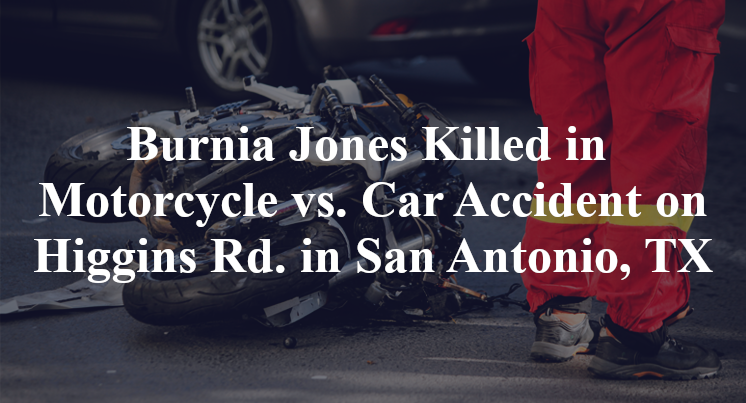Burnia Jones Killed in Motorcycle vs. Car Accident on Higgins Rd. in San Antonio, TX
San Antonio, TX — February 6, 2025, Burnia Jones was killed following a motorcycle versus car accident at approximately 5:00 p.m. along Higgins Road.
According to authorities, 61-year-old Burnia Jones was traveling on a southeast bound motorcycle on Higgins Road at the Uhr Lane when the accident took place.

Officials indicate that, for as yet unknown reasons, the motorcycle failed to stop for a stop sign, entering the intersection at an apparently unsafe time. This resulted in a collision between the motorcycle and a Nissan Xterra that had been turning left from Uhr Lane to Higgins Road. The impact caused the Nissan to swerve and crash into another vehicle, a Chevrolet Corvette, that had been at a stop waiting to make a left turn onto Uhr Lane.
Jones reportedly suffered fatal injuries over the course of the accident and was declared deceased at the scene. Additional details pertaining to this incident are not available at this point in time. The investigation is currently ongoing.
Commentary
When a motorcyclist is killed in a crash involving multiple vehicles, and early reports suggest they may have entered an intersection at an unsafe time, it's tempting to draw conclusions. But in my experience, especially with incidents like this one on Higgins Road and Uhr Lane in San Antonio, a thorough understanding of the crash requires a broader investigation. To determine what truly happened and whether this loss of life could have been prevented, there are three essential questions that should be asked.
First, did the authorities conduct a detailed investigation into the roadway design and traffic control at the intersection? Intersections are high-risk areas for any vehicle, but especially for motorcyclists who are harder to see and more vulnerable in a collision. Investigators should evaluate the visibility of the stop sign, the presence of any obstructed sight lines, and whether lighting, signage, or road surface conditions could have influenced the rider’s ability to safely stop. Without this context, we can't be sure whether the rider had every opportunity to make a safe decision.
Second, has anyone explored whether a mechanical issue on the motorcycle may have contributed to the crash? Failing to stop at a stop sign could result not just from rider error but from issues with the brake system, throttle control, or even the motorcycle's tires. These kinds of problems are often overlooked unless a detailed forensic inspection is performed—and that’s only possible if the motorcycle is preserved in its post-crash state. If it isn’t, we may never know whether a malfunction played a role.
Lastly, has all available electronic and video evidence been reviewed? While motorcycles often lack the extensive onboard data recorders found in cars, nearby surveillance footage—such as from businesses or traffic cameras—can be incredibly valuable. It may clarify the motorcycle’s speed and position before the impact, as well as how the other vehicles were moving. If the Nissan and the Corvette involved have event data recorders, those may also contain information that helps reconstruct the sequence of events.
When a crash leaves someone dead and multiple others involved, it’s not enough to rely on assumptions based on a stop sign. Asking these questions is the least that can be done to ensure that those affected by this crash get the clarity and closure they deserve.

*We appreciate your feedback and welcome anyone to comment on our blog entries, however all visitor blog comments must be approved by the site moderator prior to showing live on the site. By submitting a blog comment you acknowledge that your post may appear live on the site for any visitors to see, pending moderator approval. The operators of this site are not responsible for the accuracy or content of the comments made by site visitors. By submitting a comment, blog post, or email to this site you acknowledge that you may receive a response with regard to your questions or concerns. If you contact Grossman Law Offices using this online form, your message will not create an attorney-client relationship and will not necessarily be treated as privileged or confidential! You should not send sensitive or confidential information via the Internet. Since the Internet is not necessarily a secure environment, it is not possible to ensure that your message sent via the Internet might be kept secure and confidential. When you fill out a contact or comment form, send us an email directly, initiate a chat session or call us, you acknowledge we may use your contact information to communicate with you in the future for marketing purposes, but such marketing will always be done in an ethical way.